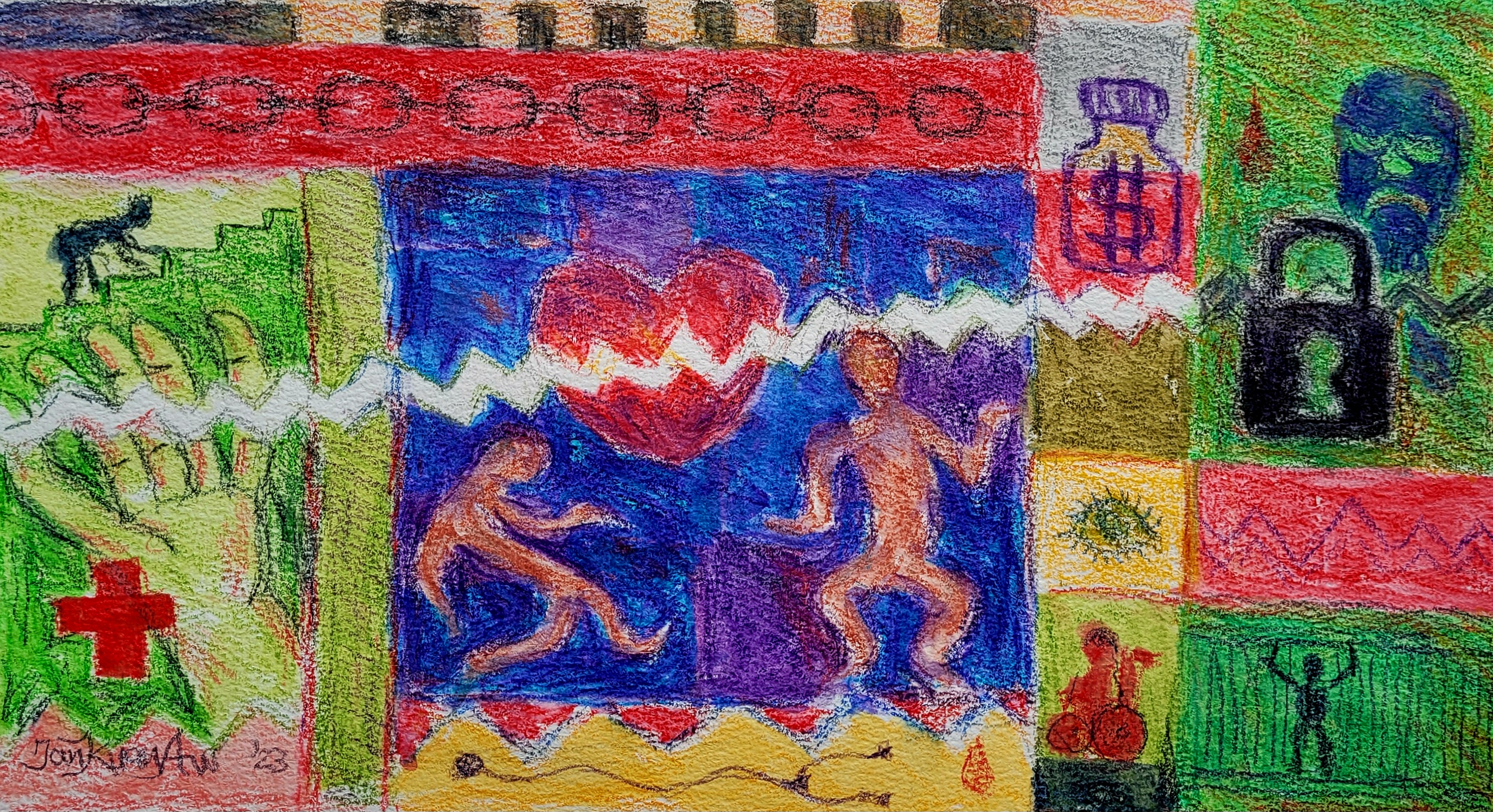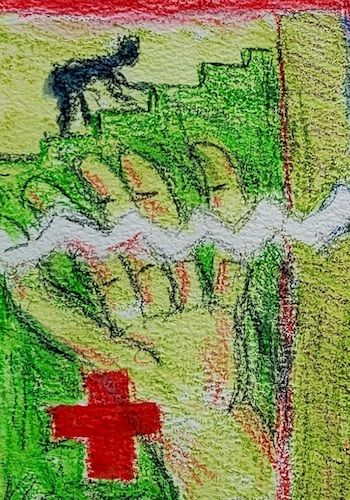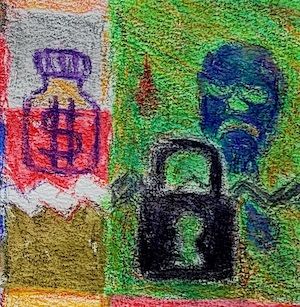Healthcare has to be healed

Hello Debriefers,
Up till now I've been exploring healthcare through extended hospital stays and fighting people looking after me. It's time to take a step back to understand how my fights relate to those faced by disabled people more widely.
This edition looks at recent research on disability and health, much of which is trying to respond to the crises exposed by the covid pandemic. In particular we're looking at a landmark study on health inequity from the World Health Organization, and work on reimagining health systems by Missing Billion.
They show us the profound health inequity disabled people face, how that impacts our lives, and what needs to be done. We get into the questions they don't dare raise about eugenics and how deep ableism goes. And we find that the solution might be in us taking revenge.
The complex pieces of this story are also told through Tan Kuan Aw's painting.

Health isn't just in the hospital
Before I read the report, I was thinking about what goes wrong when we need healthcare. I've struggled to get people to take my needs seriously and faced the pain of seeing people I love getting care in terrible conditions. People often have to sell assets to get money for treatment, and disabled people get deprioritized or excluded from the support they need. Folk can end up turning to bizarre and often harmful “treatments”.
All of that contributes to health inequities, but these reports make us see the contexts they are in, and how things add up through our lives. They're reports that remind me of the health appointments I missed during the pandemic. They remind me how my disability made more likely the serious fall that put me in hospital in the first place. They remind me to floss. Disabled people have worse oral health than people without disabilities and, yes, my regular dental check-up has been delayed by inaccessibility.
Disabled people can fall into awful cycles of ill-health and exclusion. Our underlying conditions and social marginalization mean we face higher risk factors for disease (unhealthy lifestyles and living conditions, say, or the risk of violence). Barriers to information, public health outreach and healthcare mean we don't understand, or get things addressed as soon or as effectively as we need. These factors all feed into and reinforce each other:
“creating vicious cycles of poverty, exclusion, and poor health. Because persons with disabilities are less likely to access education and employment, they are more likely than those without disabilities to live in poverty; this in turn leads to poor living conditions, adds to their exposure to ‘health-damaging’ conditions”. (WHO)
And remember, you can always speed up the cycle. Add in a mental health condition aggravated by those conditions. Or, why not, a health emergency. Like a pandemic. As we still see, the pandemic compounds these conditions with the disproportionate impacts of medical rationing, discrimination and public health measures such as lockdowns or services. The way covid brought out health inequities so clearly was one of the ways this evidence came to light.

How it adds up
The bad news is a substantial gap in health with grim outcomes for disabled people. The good news is that the data shows it can change.
Disabled people die earlier, have poorer health and are more limited by its impacts. Recent modelling from Missing Billion estimates that people with disabilities have over twice the mortality rate of people without disabilities, leading to an impact of 10-20 years off of life expectancy. And the WHO report shows that in terms of poor health, we are more likely to face health problems like tuberculosis, diabetes, strokes, or sexually transmitted infections.
Some of the grimmest disparities are seen for people with intellectual disabilities. A study in England suggested that 37% of all deaths among adults with intellectual disabilities would not have happened with more effective health care, compared to 22.5% for the general population. More data from England shows that, even after adjusting for age and other factors, people with learning disabilities were eight times more likely to do die of covid than those without.
These differences cannot be explained by our underlying impairments. While some impairments do impact health or life expectancy, WHO tells us that a “significant proportion” of the difference is “associated with unjust or unfair factors that are avoidable”. Their report calls the overall difference with non-disabled people “inequality” and the part that is caused by the unfair factors “inequity”. It's a report that shows the extent of those inequities.
One important source of those inequities is in healthcare. At the same time as people with disabilities face the increased risk of disease, we have limited or delayed access to the health services that might have prevented or treated them. Missing Billion points out, say, that as well being more likely to have diabetes, we have worse diabetes care. Aggregating estimates across seven countries suggests that women with disabilities were 22% less likely to have been screened for breast cancer and 37% less likely to have been screened for cervical cancer than women without disabilities.
In some places, health systems and broader social inclusion have substantially improved life expectancy of disabled people. In the course of a couple of generations, there has been an extraordinary change in the life expectancy of people with Down syndrome, from around 10 years to over 60. (I think this data is from richer countries.) Striking differences in rates of in-hospital mortality also show a sign of potential shortcomings in healthcare. For people with spinal injuries, in-hospital mortality is three times higher in low- and middle-income countries than high-income countries.

What it means in our lives
This evidence on health inequities shows the physical impacts of social exclusion. Whether it's communications, access, opportunities, or just an absence of minimum human respect, the barriers that disabled people face have consequences for our wellbeing. And in turn our wellbeing affects our lives. The fracture in my hip sent fractures through the rest of my life. Our lives' journeys are marked in our bodies.
The many ways disability can impact health is demonstrated in a paper from World Federation of the Deaf on why sign languages are a health need. Language deprivation affects thinking, behaviour, and development, in combination with all the social barriers it will result in. This increases risk of chronic conditions, mental health disorders, and of vulnerability or neglect. And then, when people need to address these issues or to seek healthcare there are barriers.
Looking at these impacts through our lives also shows how disability-related barriers interact with other aspects of our social identities. The WHO report usefully shows how this is true for age. The vulnerabilities of childhood are increased for children with disabilities. And at the other end of the age spectrum, stereotypes about older persons (and their experience of disability) have harmful effects.

What happens when we go to hospital
We have more health issues, and so we will be impacted more by substandard healthcare. And, unfortunately, those who need healthcare most can be those that are more likely to face blocks in getting good healthcare.
Often these can be the direct barriers of inaccessible health facilities or direct discrimination. WHO shares an example of Coumba in Senegal who, pregnant, was rejected by four health centres because the results of her childhood polio would make the delivery “too complicated”. When she did find a health centre, the midwife took the decision for a caesarean section without even examining her.
Resuming my fights with healthcare workers, WHO tells us that the “lack of knowledge and skills or miscommunication of health and care workers” contributes directly to several areas: access to services; delayed treatment; less opportunity to disclose or seek support; and an added risk of unhealthy behaviours. It contributes to us being less likely to seek healthcare and poorer care and clinical outcomes when we do.
For detailed stories of how disabled people come in and out of healthcare in low resource settings, see these gorgeously-illustrated interviews with disabled people in Cox's Bazar, Bangladesh. This was already a deprived part of a poor country before a million Rohingya refugees arrived, fleeing genocide in Myanmar. Their cases show profound barriers to getting healthcare, and how people often turn to “traditional healing practices”. Cost, of course, comes as a huge barrier, with each consultation, the transport required, and each course of medicine put at risk because of it.
Even in an area with such resource limitations, there are still good examples of how healthcare can help people, and the relief when doctors give person-centred advice and treat patients with respect. We don't need to wait to be rich for health systems to improve how they serve persons with disabilities.

What needs to be done
Disability work had often been uncomfortable with health issues, and sometimes resistant to looking at them too closely. We were resisting the the over-medicalization of our issues by looking at everything else. The pandemic has more than shown us we need to look closer. These reports are one of the ways we can see increased international focus and the resolution to work towards the “highest attainable standard of health” for persons with disabilities.
One of the principal interventions that WHO is making is to argue for more attention to disabled people from the health sector as a whole. Note that this message is not just for us on the outside: it's just as important for WHO staff. The report puts disability in terms of the organization's wider agendas of universal health care and a primary health-care approach. It also emphasises that these actions be taken through empowerment and participation of persons with disabilities and that more monitoring and evaluation need to be built in. Both of these elements are notable currently by their absence.
As for what needs to be done in practice, here WHO takes us more into the UN-land of ways forward: prioritizing, establishing, reforming, integrating, considering, adopting, and, of course, developing. For a more direct navigation of these complexities, the Missing Billion report has a good go at what it wants health systems to look like and how to get there. Its vision comes from what people say they need, and seeing how we can champion our own rights to health and support.
One of the reasons for so many recommendations is that health systems are very complex. This also means we don't necessarily know how to change them. On the Debrief we've been discussing just one part of the puzzle: what would be needed to change the attitudes of healthcare workers. I didn't have the answer, and neither does WHO. Some interventions have been shown to increase knowledge or skills, but “there are gaps in evidence of how these initiatives translate into changes in behaviours and practices.” Further, WHO warns that they do not always reflect a rights-based approach and are often designed and conducted without including disabled people.
If we don't know the effective treatment, can we be sure that we found the underlying cause?

A different diagnosis
These reports give a thorough catalogue of what's wrong, but I don't think they fully diagnosed the illness. What if it's the health systems themselves that are sick?
First off, calling them health “systems” is a misleading description of the hotchpotch of public, private, non-profit, faith-based and just plain criminal actors that “contribute” to healthcare. It doesn't speak to how health services are shaped by capitalism, the enduring nature of colonial legacies of care, or the presence of corruption in both low- and high-resource settings. And, of crucial importance for us, how public health and healthcare are structured by ableism.
I don't quite go as far as thinkers like Mia Mingus who refer to the “eugenic abandonment” of disabled people during the pandemic. But even if we don't make such a bold conclusion, we still see that eugenic tendencies are close by. In the ongoing forced sterilisation of disabled people, for example, or, as Catalina Devandas warned us, the enormous growth in prenatal screening and possibilities of genetic engineering.
Stepping down from eugenics there are many serious concerns about how much ableism shapes the scaffolding of health. How does ableism inform the way priorities are chosen? The use of Quality-Adjusted Life Years (QALYs), for example, is a cost-benefit analysis that “devalues life with a disability” and “reduces coverage of treatments disproportionately relied on by disabled people”. And what is it about medical knowledge and medical relationships that mean that they so often resist listening to patients, regardless of how well resourced the setting is?

How we take revenge
People with Ehlers-Danlos Syndrome (EDS) have a notoriously difficult time being taken seriously by health professionals. So when Isabella Cueto writes the story of how some with EDS have become scientists to research and upgrade the way the syndrome is understood and treated, she calls it “revenge of the gaslit patients”. “Patient”-led research, solidarity and action was also required for those with long covid and the reckoning it forced.
Here, we agree with the WHO report, which puts an appropriate emphasis on “participation”. I can confirm from my own experience the importance of being in a joint construction of care: working with physiotherapists to adjust their ideals to my life, finding a surgeon that listens, or the chance I had to share my experiences with the board of the hospital and beyond. Those moments of being taken seriously can feel like you found water in the desert. When they do arrive it does indeed amount to a kind of revenge, accounting for what has gone before.
Healthcare is sick and we can help to heal it. In the meantime, I need to book an appointment at an accessible dentist.
Stay well,
Peter
Acknowledgements
The painting is by Tan Kuan Aw.
With thanks to brainstorming conversations with Áine, Davey, Sander and Stefan, and the many others with whom I've been discussing health issues with over the past years.
This edition counts on support from Sightsavers, Light for the World and the people and organizations that read it.
